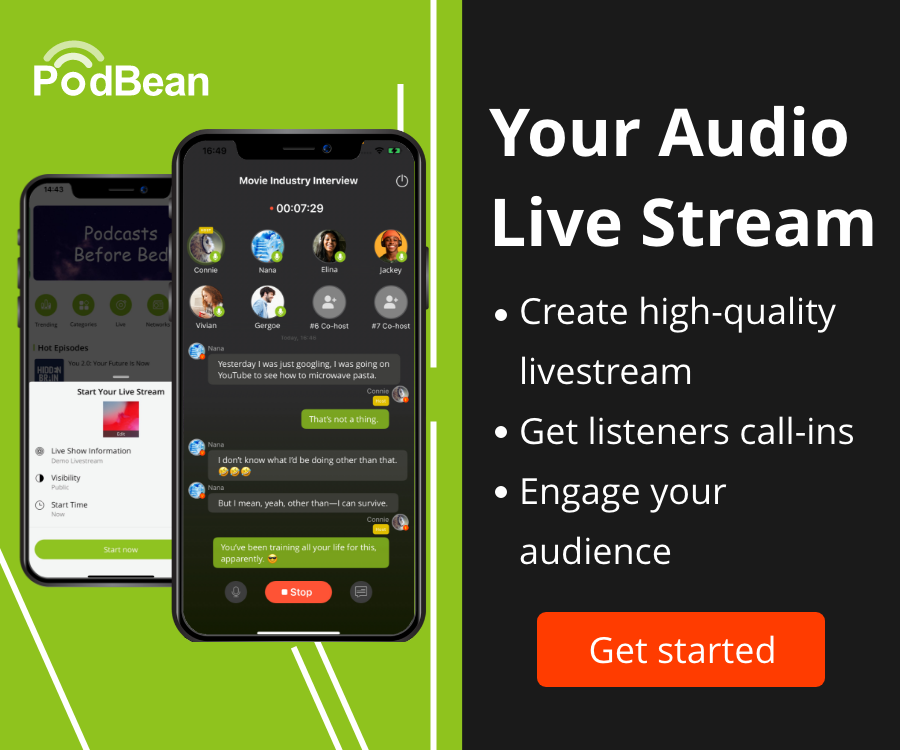
- Podcast Features
-
Monetization
-
Ads Marketplace
Join Ads Marketplace to earn through podcast sponsorships.
-
PodAds
Manage your ads with dynamic ad insertion capability.
-
Apple Podcasts Subscriptions Integration
Monetize with Apple Podcasts Subscriptions via Podbean.
-
Live Streaming
Earn rewards and recurring income from Fan Club membership.
-
Ads Marketplace
- Podbean App
-
Help and Support
-
Help Center
Get the answers and support you need.
-
Podbean Academy
Resources and guides to launch, grow, and monetize podcast.
-
Podbean Blog
Stay updated with the latest podcasting tips and trends.
-
What’s New
Check out our newest and recently released features!
-
Podcasting Smarter
Podcast interviews, best practices, and helpful tips.
-
Help Center
-
Popular Topics
-
How to Start a Podcast
The step-by-step guide to start your own podcast.
-
How to Start a Live Podcast
Create the best live podcast and engage your audience.
-
How to Monetize a Podcast
Tips on making the decision to monetize your podcast.
-
How to Promote Your Podcast
The best ways to get more eyes and ears on your podcast.
-
Podcast Advertising 101
Everything you need to know about podcast advertising.
-
Mobile Podcast Recording Guide
The ultimate guide to recording a podcast on your phone.
-
How to Use Group Recording
Steps to set up and use group recording in the Podbean app.
-
How to Start a Podcast
-
Podcasting
- Podcast Features
-
Monetization
-
Ads Marketplace
Join Ads Marketplace to earn through podcast sponsorships.
-
PodAds
Manage your ads with dynamic ad insertion capability.
-
Apple Podcasts Subscriptions Integration
Monetize with Apple Podcasts Subscriptions via Podbean.
-
Live Streaming
Earn rewards and recurring income from Fan Club membership.
-
Ads Marketplace
- Podbean App
- Advertisers
- Enterprise
- Pricing
-
Resources
-
Help and Support
-
Help Center
Get the answers and support you need.
-
Podbean Academy
Resources and guides to launch, grow, and monetize podcast.
-
Podbean Blog
Stay updated with the latest podcasting tips and trends.
-
What’s New
Check out our newest and recently released features!
-
Podcasting Smarter
Podcast interviews, best practices, and helpful tips.
-
Help Center
-
Popular Topics
-
How to Start a Podcast
The step-by-step guide to start your own podcast.
-
How to Start a Live Podcast
Create the best live podcast and engage your audience.
-
How to Monetize a Podcast
Tips on making the decision to monetize your podcast.
-
How to Promote Your Podcast
The best ways to get more eyes and ears on your podcast.
-
Podcast Advertising 101
Everything you need to know about podcast advertising.
-
Mobile Podcast Recording Guide
The ultimate guide to recording a podcast on your phone.
-
How to Use Group Recording
Steps to set up and use group recording in the Podbean app.
-
How to Start a Podcast
-
Help and Support
- Discover

Powering Microservices Using Apache Kafka on Node.js with KafkaJS at Klarna ft. Tommy Brunn
At Klarna, Lead Engineer Tommy Brunn is building a runtime platform for developers. But outside of his professional role, he is also one of the authors of the JavaScript client for Apache Kafka® called KafkaJS, which has grown from being a niche open source project to the most downloaded Kafka client for Node.js since 2018.
Using Kafka in Node.js has previously meant relying on community-contributed bindings to librdkafka, which required you to spend more of your time debugging failed builds than working on your application. With the original authors moving away from supporting the bindings, and the community only partially picking up the slack, using Kafka on NodeJS was a painful proposition.
Kafka is a core part of Klarna’s microservice architecture, with hundreds of services using it to communicate among themselves. In 2017, as their engineering team was building the ecosystem of Node.js services powering the Klarna app, it was clear that the experience of working with any of the available Kafka clients was not good enough, so they decided to perform something similar for the Erlang client, Brod, and build their own. Rather than wrapping librdkafka, their client is a complete reimplementation in native JavaScript, allowing for a far superior user experience at the cost of being a lot more work to implement. Towards the end of 2017, KafkaJS 0.1.0 was released.
Tommy has also used KafkaJS to build several Kafka-powered services at Klarna, as well as worked on supporting libraries such as integrations with Confluent Schema Registry and Zstandard compression.
Since KafkaJS is written entirely in JavaScript, there is no build step required. It will work 100% of the time in any version of Node.js and evolve together with the platform with no effort required from the end user. It also unlocks some creative use cases. For example, Klarna once did an experiment where they got it to run in a browser. KafkaJS will also run on any platform that’s supported by Node.js, such as ARM. Klarna’s “no dependencies” policy also means that the deployment footprint is small, which makes it a perfect fit for serverless environments.
EPISODE LINKS
- Node.js ❤️ Apache Kafka – Getting Started with KafkaJS
- Join the Confluent Community
- Learn more with Kafka tutorials, resources, and guides at Confluent Developer
- Live demo: Kafka streaming in 10 minutes on Confluent Cloud
- Use 60PDCAST to get an additional $60 of free Confluent Cloud usage (details)
More Episodes
 2022-07-21
2022-07-21
 2022-06-23
2022-06-23
 2022-06-09
2022-06-09
Create your
podcast in
minutes
- Full-featured podcast site
- Unlimited storage and bandwidth
- Comprehensive podcast stats
- Distribute to Apple Podcasts, Spotify, and more
- Make money with your podcast
It is Free
- Privacy Policy
- Cookie Policy
- Terms of Use
- Consent Preferences
- Copyright © 2015-2025 Podbean.com




